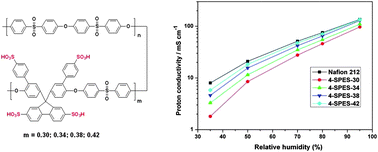A clustered sulfonated poly(ether sulfone) based on a new fluorene-based bisphenol monomer†
Abstract
A new

* Corresponding authors
a
WCU Department of Energy Engineering, College of Engineering, Hanyang University, Seoul 133-791, Republic of Korea
E-mail:
ymlee@hanyang.ac.kr, michael.guiver@nrc-cnrc.gc.ca
Fax: +82-2-2291-5982
Tel: + 82-2-2220-0525
b School of Materials Science and Engineering, Changzhou University, Changzhou, China
c School of Chemical Engineering, College of Engineering, Hanyang University, Seoul 133-791, Republic of Korea
d National Research Council Canada, Ottawa, Ontario, Canada
A new

 Please wait while we load your content...
Something went wrong. Try again?
Please wait while we load your content...
Something went wrong. Try again?
C. Wang, D. W. Shin, S. Y. Lee, N. R. Kang, G. P. Robertson, Y. M. Lee and M. D. Guiver, J. Mater. Chem., 2012, 22, 25093 DOI: 10.1039/C2JM34414A
To request permission to reproduce material from this article, please go to the Copyright Clearance Center request page.
If you are an author contributing to an RSC publication, you do not need to request permission provided correct acknowledgement is given.
If you are the author of this article, you do not need to request permission to reproduce figures and diagrams provided correct acknowledgement is given. If you want to reproduce the whole article in a third-party publication (excluding your thesis/dissertation for which permission is not required) please go to the Copyright Clearance Center request page.
Read more about how to correctly acknowledge RSC content.
 Fetching data from CrossRef.
Fetching data from CrossRef.
This may take some time to load.
Loading related content
